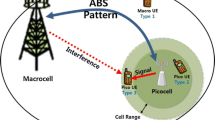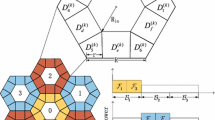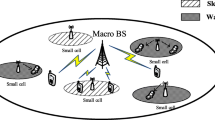Abstract
This paper investigates the problem of distributed joint channel and time slot selection for interference mitigation in the multiple microcells system, where each microcell user determines which channel it should occupy and when it should get access to the serving microcell base station. Considering the characteristics of local interference, a distributed inter-cell time–frequency resource scheduling scheme is proposed, where neighboring users can get access to the same channel at different time slots or different channels at the same time slot. Then, a game is formulated to model the problem, in which the utility function of a individual user is the number of neighboring users occupying the same channel at the same time slot. It is proved to be an exact potential game with at least one pure strategy Nash Equilibrium (NE) point. Moreover, in order to achieve global interference minimization via local information, we propose the Heterogeneous Independent Revision Process (HIRP) to obtain the NE, which allows all users to update their selections simultaneously. Finally, numerical results show that our proposed HIRP guarantees that the interference minimization game converges to the NE and the proposed scheme acquires better performance compared with other existing interference management scheme.







Similar content being viewed by others
References
Chandrasekhar, V., Andrews, J. G., & Gatherer, A. (2008). Femtocell networks: A survey. IEEE Communications Magazine, 46(9), 59–67.
Andrews, J. G., Claussen, H., Dohler, M., Rangan, S., & Reed, M. C. (2012). Femtocells: Past, present, and future. IEEE Journal on Selected Areas in Communications, 30(3), 497–508.
Tang, L., Li, Y., Chen, L., Yin, S., & Li, S. (2014). Interference coordination for co-channel deployed macrocell and small cell cluster. In Proceedings of the IEEE VTC 2014.
Zhang, H., Wang, Y., & Ji, H. (2016). Resource optimization-based interference management for hybrid self-organized small-cell network. IEEE Transactions on Vehicular Technology, 65(2), 936–946.
Zhao, W., Wang, S., Wang, C., & Wu, X. Approximation algorithms for cell planning in heterogeneous networks. IEEE Transactions on Vehicular Technology (to appear).
Ahuja, K., Xiao, Y., & van der Schaar, M. (2015). Distributed interference management policies for heterogeneous small cell networks. IEEE Journal on Selected Areas in Communications, 33(6), 1112–1126.
Li, Y., Celebi, H., Daneshmand, M., & Wang, C. (2013). Energy efficient femtocell networks: Challenges and opportunities. IEEE Wireless Communications, 20(6), 99–105.
Sun, X., & Wang, S. (2015). Resource allocation scheme for energy saving in heterogeneous networks. IEEE Transactions on Wireless Communications, 14(8), 4407–4416.
Zhang, Y., & Wang, S. (2016). Resource allocation for cognitive radio-enabled femtocell networks with imperfect spectrum sensing and channel uncertainty. IEEE Transactions on Vehicular Technology, 65(9), 7719–7728.
Hamza, A. S., Khalifa, S. S., Hamza, H. S., & Elsayed, K. (2013). A survey on inter-cell interference coordination techniques in OFDMA-based cellular networks. IEEE Communications Surveys and Tutorials, 15(4), 1642–1670.
Giovany, T.I., Usman, U.K., & Prasetya, B. (2013). Simulation and analysis of interference avoidance using fractional frequency reuse (FFR) method in LTE femtocell. In Proceedings of the IEEE ICoICT 2013.
Das, S., Viswanathan, H., & Rittenhouse, G. (2003). Dynamic load balancing through coordinated scheduling in packet data systems. In Proceedings fo the IEEE INFOCOM 2003.
Samarakoon, S., Bennis, M., Saad, W., & Latva-aho, M. (2013). Backhaul-aware interference management in the uplink of wireless small cell networks. IEEE Transactions on Wireless Communications, 12(11), 5813–5825.
Li, Y., Yu, J., Wang, C., Liu, Q., Cao, B., & Daneshmand, M. (2012). A novel bargaining based incentive protocol for opportunistic networks. In IEEE global communications conference, pp. 5285–5289.
Aliu, O., Imran, A., & Evans, B. (2013). A survey of self organisation in future cellular networks. IEEE Communications Surveys and Tutorials, 15(1), 336–361.
Xu, Y., Wang, J., Wu, Q., Anpalagan, A., & Yao, Y. (2012). Opportunistic spectrum access in cognitive radio networks: Global optimization using local interaction games. IEEE Journal of Selected Topics in Signal Processing, 6(2), 180–194.
Young, H. P. (1998). Individual strategy and social structure. Princeton, NJ: Princeton Univ. Press.
Li, H., et al. (2010). Graph method based clustering strategy for femtocell interference management and spectrum efficiency improvement. In Proceedings of the IEEE WiCOM 2010.
Jain, K., Padhye, J., Padmanabhan, V. N., & Qiu, L. (2005). Impact of interference on multi-hop wireless network performance. IEEE Wireless Networks, 11(4), 471–487.
Zheng, J., Cai, Y., & Anpalagan, A. (2015). A stochastic game-theoretic approach for interference mitigation in small cell networks. IEEE Communications Letters, 19(2), 251–254.
Jafari, A., Greenwald, A., Gondek, D., & Ercal, G. (2001). On no-regret learning, fictitious play, and Nash equilibrium. In Proceedings of the IEEE EICML 2001.
Hart, S., & Mas Colell, A. (2000). A simple adaptive procedure leading to correlated equilibrium. Econometrica, 68(5), 1127–1150.
Neel, J.O., Reed, J.H., & Gilles, R.P. (2004). Convergence of cognitive radio networks. In Proceedings of the IEEE WCNC 2004.
Marden, J. R., & Shamma, J. S. (2012). Revisiting log-linear learning: Asynchrony, completeness and payoff-based implementation. Games and Economic Behavior, 75(2), 788–808.
Xu, Y., Wu, O., Wang, J., et al. (2013). Opportunistic spectrum access using partially overlapping channels: Graphical game and uncoupled learning. IEEE Transactions on Communications, 61(9), 3906–3918.
Marden, J., Arslan, G., & Shamma, J. (2009). Cooperative control and potential games. IEEE Transactions on Systems, 39(6), 1393–1407.
Acknowledgements
The authors would like to thank the editors and the anonymous reviewers, whose invaluable comments helped improve the presentation of this paper substantially.
Author information
Authors and Affiliations
Corresponding author
Rights and permissions
About this article
Cite this article
Wang, H., Wang, J., Wang, C. et al. Joint frequency and time resource partitioning for OFDM-based small cell networks. Wireless Netw 24, 1979–1989 (2018). https://doi.org/10.1007/s11276-016-1429-2
Published:
Issue Date:
DOI: https://doi.org/10.1007/s11276-016-1429-2




